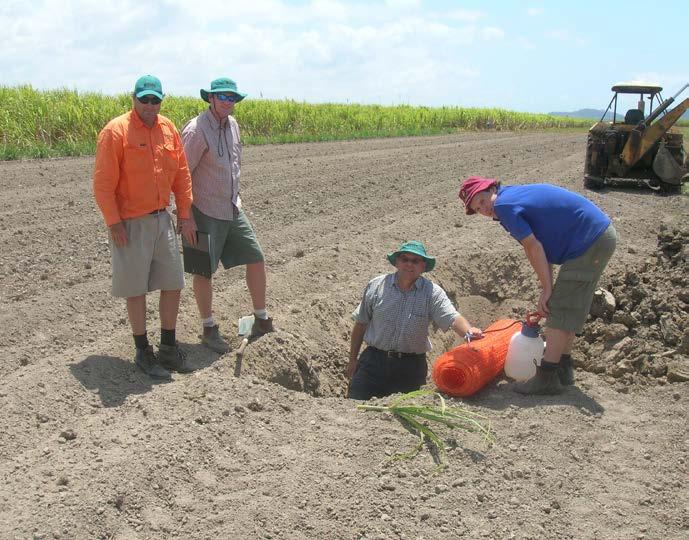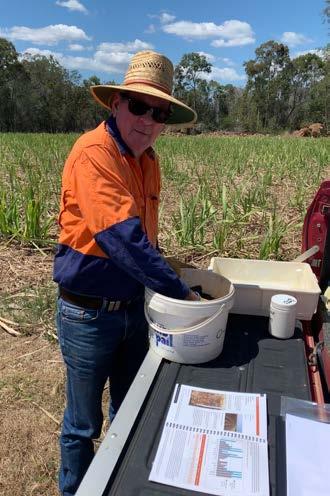
6 minute read
Step back in time
BY RENEE CLUFF
Two decades after the first SIX EASY STEPS® grower workshop, we re-visit the origins of the sugarcane industry’s best practice nutrient management program and examine how it has evolved over time.
Sugarcane growers today know the SIX EASY STEPS program not only as a basis for Smartcane BMP accreditation, but as an agronomic tool that allows them to customise nutrient management planning according to block or paddock variables.
Importantly, it considers all essential nutrients for sugarcane production: not just nitrogen (N) and phosphorus (P)! It also recognises how these nutrients interact with differing soil properties to deliver profitable sugarcane production without adversely impacting soil fertility or off-farm effects.
The leader of the program is Professor Bernard Schroeder (University of Southern Queensland), who began his scientific investigations in the 1990s when he was employed by the then Bureau of Sugar Experimentation Stations (BSES) – now Sugar
Research Australia (SRA) – as a research scientist. His position was created within the Cooperative Research Centre for Sustainable Sugar Production (CRC Sugar) to undertake a review of nutrient management in the industry.

“One of the things I identified was that the nutrient management guidelines weren’t soil specific,” Bernard said. “For instance, when it came to N application rates, there was a category for rich land soils and another for all the other soils. The latter was split according to those applicable to the Burdekin/Mareeba districts and all other districts. It was also suggested that growers adjust rates according to the sugar price.
“I got in touch with Dr Andrew Wood, who was the CSR Ltd Chief Technical Field Officer stationed at Macknade Mill. We quickly found common ground because of our very similar opinions of how best to manage soils and nutrients in sugarcane production systems. We were both concerned that the existing nutrient recommendations were inadequate and required modification.
“From there, we wanted to develop and promote a set of nutrient management guidelines that reflected the diversity of soils and districts within the Australian sugar industry and we have worked collaboratively for this purpose for almost 28 years now.”
The team grew, with John Panitz, the late Dr Phil Moody, Dr Barry Salter, David Calcino, Alan Hurney, Dr Danielle Skocaj and Glen Park rounding-out the SIX EASY STEPS RD&E team.
“Others like Phil Netz, John Jackson, Eric Kok, Sam Henty and Zofia Ostatek-Boczynski provided technical support, and people like Bob Stewart, Jason Benn, Evan Shannon, Robert Sluggett, Dr Bob Aitken, Rick Beattie, Peter McGuire, Jim Sullivan, Victor Schwenke and Scott Hardy shared their local knowledge over the years,” Bernard added.

Multiple industry organisations were brought together through this team effort, including BSES/ SRA, Queensland CANEGROWERS , CSR Sugar, the Sugar Research and Development Corporation (SRDC), the Queensland Departments of Natural Resources and Primary Industries, and various Productivity Boards, Natural Resource Management groups and milling companies.
“There were some people who thought the previous nutrient management guidelines were adequate. Consequently, we’ve had to spend a lot of time over the years defending what we were doing,” Bernard said. “Over time, we convinced the sceptics more and more that the SIX EASY STEPS program and knowledge of soils enabled better on-farm decision-making.
“The science that underpins the system is robust and the nature of what we’ve developed is both logical and understandable. Importantly, the order of the SIX EASY STEPS is chronological, and STEPS 5 and 6 in particular offer opportunities for cyclical learning and continuous improvement.
“Initially, train-the-trainer courses were held as part of CRC Sugar and brought together knowledge of the properties of Australian sugarcane-producing soils. Those courses ran over two days and included presentations of various topics and practical soil-based workshop activities.
“In 2004, the first grower-oriented short course was conducted in Bundaberg,” Bernard said. “The name ’SIX EASY STEPS’ was the brainchild of a local journalist, Carole Colville, who I’d been talking to about the program. It came to life when those short courses were presented and ever since then it has been badged as the SIX EASY STEPS and recognised as the basis for BMP.”
That’s when and where the SIX EASY STEPS was born
Soil booklets for each district were rolled- out over successive years, along with a toolbox to value-add to the level of support that growers could access. The SIX EASY STEPS Advisory Committee (SESAC) was established more recently to vet the incorporation of potential tools into the toolbox.
Over the years, one of the major changes was to STEP 5, which was originally ‘Use leaf analysis to check the adequacy of fertiliser inputs’. As a response to industry feedback, it’s now not so specific, and includes provisions for on-farm assessments and growermanaged on-farm strip-trials.
“If or when there are changes that need to be made within the guidelines, we’ve dealt with that through our investigative work,” Bernard said. “When new, robust and valid evidence comes from science, we can update the guidelines accordingly.
Extending The Science
David Calcino worked at BSES and SRA as an advisor and extension officer for 40 years until his semi-retirement in 2017.
“The most rewarding activity I was involved in was the SIX EASY STEPS program,” he said. “From the very early days in the development of the program, the leader, Bernard, involved extension in the formative planning stage. This allowed practical input from a future extension perspective while providing project ownership.”
Sugar Research Australia’s Principal Agronomist, Dr Danielle Skocaj, has been involved with SIX EASY STEPS since 2007. She said today, refresher courses (in addition to full day workshops) that focus on different facets of the program – such as how to interpret soil test results (STEP 4) – are held at suitable times of the year.
“Scientific knowledge has been packaged into a palatable form, which includes multimedia resources, faceto-face workshops, practical hands-on training and online tools,” she said. “It’s very visible how growers’ knowledge of nutrient management has changed over the years.”







